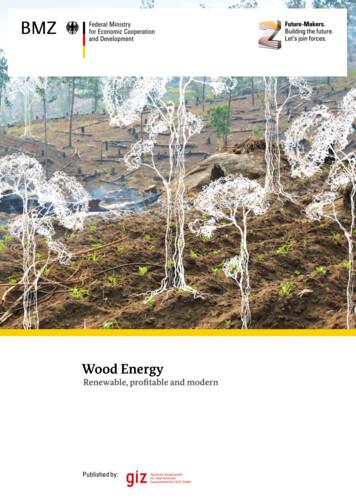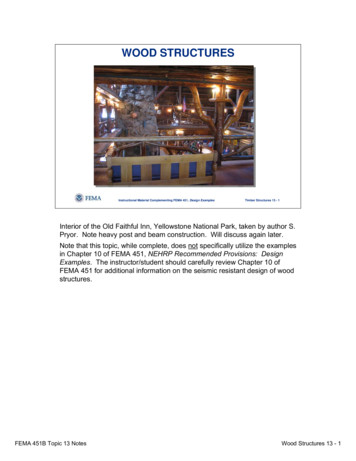Wood Design Properties - Structures Contact
Architecture 324Structures IIWood Design Properties Dimensioned SizesMoisture and DryingGradingEngineered Wood ProductsUniversity of Michigan, TCAUPStructures IISlide 1 of 16SIZE NOMINCLATUREFull Sawn 2 x 4Rough Sawn 1 3/4 x 3 3/4Full Sawn The size delivered is the full nominalsize Not generally availableDressed S4S 1 1/2 x 3 1/2Rough Sawn Rough sawn condition with no surfaceplaning Because no surfaces are planed, sizesare approximately 1/8” larger than S4SDressed The size after shrinkage from dryingand surface planing Typically dressed on all 4 sidesS4SUniversity of Michigan, TCAUPStructures IISlide 2 of 16
SIZE CATAGORIESUniversity of Michigan, TCAUPStructures IISlide 3 of 16Structures IISlide 4 of 16SIZE CATAGORIESUniversity of Michigan, TCAUP
Moisture Content MC %water to oven dry woodIn a living tree, MC can be 200%“free water” is contained in cell cavity“bound water” is within the cell wallFiber Saturation Point (FSP) is theMC at 0% free and 100% bound waterFSP is about 30% Equilibrium Moisture Content (EMC) isreached in serviceLiving treeFSPShrinkage Shrinkage begins once MC FSP Shrinkage is not the same in eachdirection Uncontrolled shrinkage results in splitsEMCUniversity of Michigan, TCAUPWood StructuresSlide 5/18Shrinkage Is different in different directionsLongitudinal is the leastAcross the grain is moreCircumferential is greatestCut Plain Sawn – most economical andcommon Quarter Sawn – less warping Rift Sawn – least warping but more wasteUniversity of Michigan, TCAUPStructures IISlide 6 of 16
Yard Dry Initial free water is removedAir dried outdoors or under coverDry rate depends on humidity and circulationCoating ends reduces splittingTakes some monthsKiln Dry Enclosed in humidity controlled chamberIntroduction of controlled heatAir circulationDried to %18University of Michigan, TCAUPStructures IISlide 7 of 16GRADINGVisual GradingEach member is assessed for visualdefects. (splits, knots, density, etc.)Machine Evaluated Lumber (MEL)Each member is assessed for density usingx-ray technology.Machine Stress Rated (MSR)Each member is stressed by running itthrough rollers which measure thedeflection and stiffness. The E modulus inbending can be calculated from thedeflection.University of Michigan, TCAUPStructures IISlide 8 of 16
GROWTH CHARACTERISTICSAnnual Rings Latewood is denser and strongerthan earlywood.Sapwood is the actively living part ofthe tree. It is younger and transportswater more readily than heartwood.The strength of the two is about thesame.Density can be gauged visually bynoting the % of latewood to earlywoodKnots Knots result from tree branchesKnots weaken the member and effectthe gradingUniversity of Michigan, TCAUPStructures IISlide 9 of 16Structures IISlide 10 of 16Checks, Shakes and Splits All three are defects which weakenthe wood Checks and splits are seasoningdefects Shakes result from stress in thegrowing treeUniversity of Michigan, TCAUP
Slope of Grain The slope of the grain is taken inrelation to the long edge of the member It is measured as a ratioe.g. 1” in 8” Increase in slope lowers the strengthof the memberUniversity of Michigan, TCAUPStructures IISlide 11 of 16Engineered Wood ProductsGlulam Glue laminated lumberStress rated and gradedParallel grainDifferent finish gradesStandard widths and lamsStraight or curvedSize limit by transportationStock or custom dimensions2005 NDSUniversity of Michigan, TCAUPStructures IISlide 12 of 16
Engineered Wood ProductsPrefabricated Wood I-Joists ASTM D 5055Standard dimensionsSpecifications per manufacturerUniversity of Michigan, TCAUPStructures IISlide 13 of 16Engineered Wood ProductsStructural Composite Lumber Laminated Veneer Lumber (LVL)–Veneer ¼” Parallel Strand Lumber (PSL)–Strand thickness ¼” Specifications per manufacturerUniversity of Michigan, TCAUPStructures IISlide 14 of 16
Engineered Wood ProductsWood Structural Panels Plywood – cross laminated wood veneer panelspressed and glued. Oriented Strand Board (OSB) – crosslaminated layers of wood strands or wafers,compressed and glued Composite Panel – wood veneer andreconstituted wood based materialUniversity of Michigan, TCAUPStructures IISlide 15 of 16Engineered Wood ProductsWood Structural Panels Cross Laminated Timber (CLT) – crosslaminated wood panels using at least threelayers of boards or dimensioned lumber pressedand glued together. Thickness of layers variesfrom 5/8 inch to 2.0 inches. The width to piecesmay vary from 2.4 to 9.5 inches. Panels areproduced in different widths – commonly: 2 ft., 4ft., 8 ft., 10 ft. and up to 60 ft. length.University of Michigan, TCAUPStructures IISlide 16 of 16
Structures II Wood Design Properties Dimensioned Sizes Moisture and Drying Grading Engineered Wood Products University of Michigan, TCAUP Structures II Slide 1 of 16 SIZE NOMINCLATURE Full Sawn The size delivered is the full nominal size Not generally available .
wood (see Section "Role of wood moisture content on corrosion"). 3. Wood preservatives Wood preservatives are chemicals that are injected into the wood to help the wood resist attack by decay fungi, mold, and/or termites. Waterborne wood preservatives are commonly used when the wood may be in contact with humans or will be painted.
3 Key Advantages of Wood-based Fuels 1.1 Wood energy is widely used and renewable 1.2 Sustainable wood production safeguards forest functions 1.3 Wood energy is available locally 1.4 Wood energy provides employment and income 1.5 Wood energy supports domestic economies 1.6 Wood energy is modern and leads to innovation 1.7 Wood energy can make a country independent of energy imports
Wood Science and Technology. Wood Science .that body of knowledge applicable to . wood as a material, including its origin, properties, composition and characteristics. Wood Technology .the application of knowledge in the conversion, processing and the many uses of wood, including the design, manufacture and marketing of wood products.
wood trusses. The versatility of wood trusses makes it an excellent roof framing system in hybrid construction where wood trusses are commonly used with steel, concrete or masonry wall systems. Environmental: Wood, the only renewable building material, has numerous environ-mental advantages. Wood trusses enhance wood's environmental
SS EN 1992 Design of concrete structures 4 4 SS EN 1993 Design of steel structures 20 14 SS EN 1994 Design of composite steel and concrete structures 3 3 SS EN 1995 Design of timber structures * * SS EN 1996 Design of masonry structures * * SS EN 1997 Geotechnical design 2 2 SS EN 1998 Design of structures for earthquake
The basic approach to the lateral design of wood structures is the same as for other structures. Horizontal elements Vertical elements Resultant inertial forces G r o u n d M o t io n Slide emphasizes that basic design principles apply to wood structures. Horizontal and vertical elements of resistance need to be identified and designed.
Examples of Wood Structures in Stream Design Root wads- one of the first wood stream restoration structures developed, used for bank protection and as an aquatic habitat element Toe wood- commonly used as a bank stabilization treatment that also enhances aquatic habitat
Lisa Little, Joan Wagner, and Anne Sutherland Boal 216 13. Emergency Preparedness and Response Yvonne Harris 232 14. Nursing Leadership through Informatics Facilitating and Empowering Health Using Digital Technology Shauna Davies 249 15. Regulation, the Law, Labour Relations, and Negotiations Beverly Balaski 261 16. Emerging Nursing Leadership Issues Brendalynn Ens, Susan Bazylewski, and Judy .























